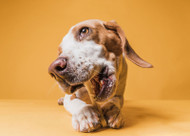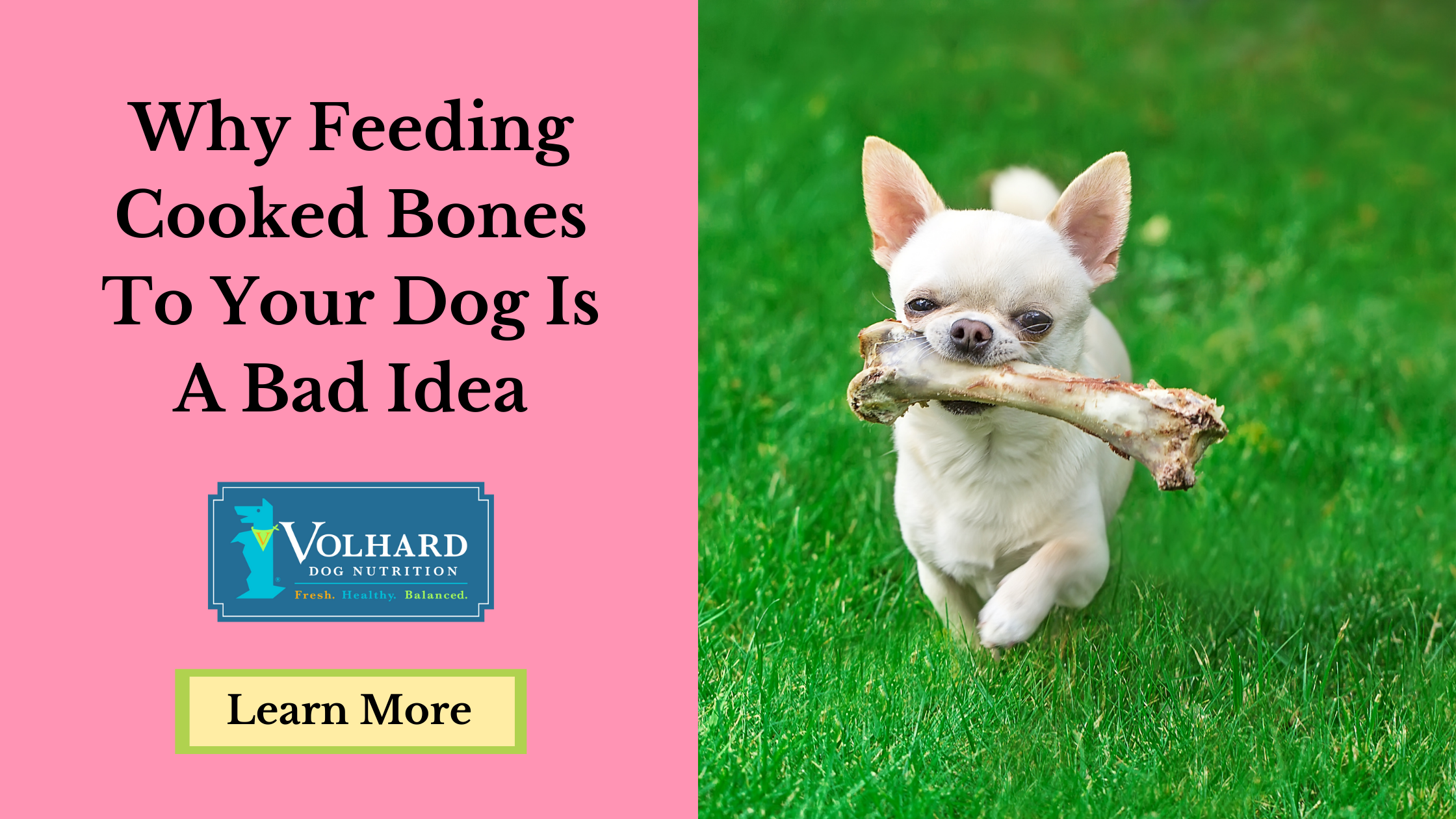Why Feeding Cooked Bones to Your Dog is a Bad Idea
Posted by Volhard Dog Nutrition on Jul 21st 2021
You’ve probably heard that dogs love to chew on bones. You’ve probably also heard that bones are dangerous for dogs. With all the contradictory information out there about feeding bones to dogs, it’s important to be able to sort out what the facts are, including both the health benefits and risks. Giving your dog a bone can be very dangerous, or, if you’re well-informed and follow some simple rules, it can be safe and even good for your pup. The first and natural answer that comes to mind is, “Yes, why shouldn’t you?” After all, bones are a fantastic source of nutrients; they prevent plaque buildup, gum disease, and the development of some unwanted behavior traits, such as excessive scratching or paw licking.
However, dog owners must learn beforehand which bones can satisfy their dog’s appetites without putting their lives in jeopardy. As such, from a “safe” to “dangerous” scale, raw bones tend towards the “safe” end, while cooked bones are surely tilting towards “dangerous.” However, even in the case of raw bones, not all bones deserve a spot on your puppy’s food bowl. From injury to ingesting parasites and other harmful bacteria, bones can turn from friend to foe in a heartbeat.
To avoid unwanted or even life-threatening situations, we have put together a very informative blog post for you on the subject of bone feeding. By the end of today’s blog, you will master everything there is to know about why & how to feed bones to your dog and which bone types to feed or avoid for your dog. Let’s dive deeper into the subject and learn more about proper bone feeding!
Avoiding Cooked Bones Right From the Start
Many dog owners hear from the beginning that staying away from cooked chicken bones is a must. The list doesn’t end there; ALL cooked bones are bad for your dog’s health! The main reason behind this statement derives from the cooking process. As they go through the cooking, steaming, or frying process, bones change their structure and become brittle and predisposed towards breaking into sharp pieces. Cooked bones, including those that come from table scraps, are not safe for dogs to eat. They can easily break and splinter. Dogs who eat cooked bones may suffer from the following:
- Broken teeth
- Mouth or tongue injuries
- Bones looped around the lower jaw
- Windpipe, esophagus, or gastrointestinal blockage
- Constipation
- Rectal bleeding
- Peritonitis–a bacterial infection of the abdomen caused by punctures in the stomach or intestines
What About Raw Bones?
Although the story of raw bones for dogs is a merrier one, we still recommend that you exercise caution. After all, accidents tend to happen when you least expect them, which is why you should make sure that your dog eats safely. When choosing a raw bone for your dog, look for one that’s about the size of its head. The reasoning behind this piece of advice is simple: dogs cannot swallow big bones easily. Such a simple solution counteracts some dogs’ natural tendency towards protecting and eating their bones too quickly. Simultaneously, take the time to observe your dog’s eating habits and prevent future accidents from the start. However, don’t forget that your dog’s time with the bone is special, which is why you should study your dog’s eating patterns from afar.
The next target on the raw bone “safety” list has to do with viruses and bacteria. It’s all about their source; purchasing raw bones from a trustworthy butcher with locally sourced meat constitutes a safe approach. When dealing with unhealthy sources, raw bones can communicate food-borne bacteria such as salmonella. You should throw the bone out after no more than two hours, even though it comes from a trustworthy source. Most raw bones that have not been cooked are edible for dogs. Raw chicken, turkey, lamb, or beef bones are soft enough to chew, eat, and digest.
That said, with all bones, there is a risk of choking if your dog swallows without thoroughly chewing, and bones that are too hard can cause damage to the teeth. Always supervise your dog with a bone. Recreational bones are not designed to be edible, but rather chewed by dogs. These can include large femur or hip bones from bison or beef and are filled with marrow. These bones may have meat, cartilage, or soft tissue still attached. You can usually find these at your local butcher.
Bones with marrow are high in fat. Make sure to adjust your dog’s diet to compensate, and if your dog needs a low-fat diet, you may be better off not giving marrow-filled bones to your dog.
With raw bones and meat, there is some risk of bacterial contamination. You can reduce these risks with proper handling. Ask your vet for suggestions about the best way to safely handle and store raw bones.
Again, there are risks to giving your dog these kinds of bones, though if you follow the safety guidelines, your pup should be able to safely enjoy them.
Why and How to Feed Bones to Your Dog
Now that we know which bone feeding practices to avoid, let’s turn our attention towards y & how to feed bones to your dog. The truth is, dogs are more than happy to receive bones as a special treat once or twice a week. Following this schedule will ensure the proper calcium intake for your dog, and you should pay close attention to your dog’s calcium levels: too much calcium will throw off the calcium/phosphorus ratio in your dog’s body. At the same time, too little calcium will result in growth defects and abnormalities. Furthermore, feeding too many bones to your dog will probably cause constipation and hard, chalky stools.
An astonishing benefit of bone feeding has to do with your dog’s oral hygiene. Bones act as your dog’s toothpaste, cleaning the teeth and preventing plaque and tartar from developing. Furthermore, puppies benefit the most from bones, satisfying their cravings to chew during teething (and keeping your furniture safe).
Chewing is a natural and important behavior for dogs. Recreational bones act like a brush and floss for a dog's teeth. The sinewy bones break tartar down and reduce gum disease, cleaning the teeth.Chewing also stimulates the production of saliva enzymes, which prevent plaque buildup. Dogs who chew on bones are also less likely to scratch or lick their own paws.
Raw bones are a good source of calcium, phosphorus, and other minerals. They have benefits to the digestive system, including strengthening the stomach muscles, preventing bloat, fostering healthy bowel movements, and preventing anal gland problems. In addition to physical health, chewing has the benefit of mentally stimulating dogs. This can actually reduce anxiety, which is linked to high blood pressure and heart disease.
If you’d like to give your dog a bone to eat or chew, follow these rules so they enjoy their bone safely.
- Supervise chewing: Don’t leave your dog to chew a bone alone. They may bite off too much and choke or gnaw too aggressively and cause injury.
- Throw out gnawed-down bones: If your dog chews a bone down to the brittle part, splintering becomes a problem. Additionally, a bone that has been chewed down too small becomes a choking hazard.
- Do not give bones to a dog who has had restorative dental work: These dogs are at risk for tooth breakage and dental problems.
- Do not give bones with marrow to dogs who get pancreatitis: Marrow is high in fat and can cause a flare up or diarrhea.
- Do not give a bone to a dog who’s likely to bite it in half and swallow large chunks: You know how your dog eats. If your dog swallows food quickly rather than chewing, a bone presents a risk.
- Give the bone after a meal: A less hungry dog is less likely to chew and swallow a bone quickly.
- Don’t feed your dog bones that can be swallowed whole: This depends on the size of your dog. A small chicken bone is not safe for a Great Dane, for instance.
- Give your dog bones that are longer than the length of their muzzle: This will make it impossible for them to swallow.
- Don’t feed your dog a bone cut lengthwise: A cut leg bone, for example, is more likely to splinter.
- Only let your dog chew for ten to 15 minutes at a time: This reduces the likelihood of injury.
- Refrigerate bones when not in use: Throw them out after three to four days. This reduces the likelihood of contamination.
Volhard Recommendations for Bone Feeding
As a rule of thumb, the following list encompassed the healthiest and most common bones that your dog will adore:
- Chicken: frames, wings, necks, feet
- Duck: frames, wings, necks, feet
- Turkey: necks, frames, feet
- Quail: whole or pieces
- Rabbit: whole or pieces
- Lamb: ribs, necks, spine
- Kangaroo: tails, ribs
- Emu: necks and ribs
- Goat: ribs, necks, spine
- Pig: ribs, brisket, necks
- Cow: ribs, brisket, oxtail
- Fish (small, wild-caught): sardines (whole), salmon (heads and frames)
Your dog will definitely love to have a go at any of these bones and enjoy its nutrients. However, you must bear in mind that different breeds, based on the dog’s age, chewing ability, and size, prefer different bone types. Make sure that you contact an expert in dog nutrition beforehand to ascertain the type of bone your dog will love.
Conclusion
The Volhard Natural Diet already contains the proper amount of calcium for your dog’s proper and healthy growth. With calcium intake out of the question, you should still feed a bone to your dog once or twice a week for teeth maintenance, jaw exercise, or simply for recreational chewing.
Congratulations, you’ve discovered the secrets of bone feeding for dogs! Now, you will be able to feed bones to your dog in a safe manner without worrying about accidents or other health issues. However, if you have more questions on this subject, feel free to contact us or check out our blog!
Volhard Dog Nutrition and its expert nutritionists are now offering online consultations to help more dog parents discover why, what, and how to feed their dogs the healthiest of foods! Speaking to a Volhard nutritionist will help you understand the inseparable relationship between healthy food, a healthy body, and a healthy mind. If you're interested in contacting one of our Volhard nutritionists, don't hesitate to access our consultation page!


